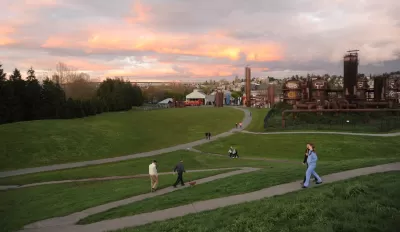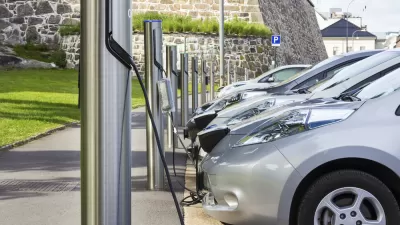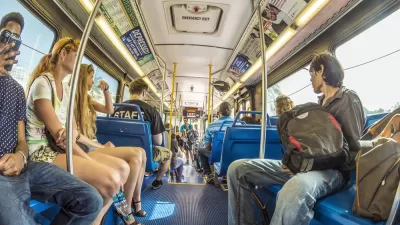The city's new transportation plan focuses on eliminating carbon emissions in its transportation sector, reducing congestion, and boosting public transit.

With its new Clean Transportation Electrification Blueprint, Seattle is embarking on an ambitious plan to electrify its transportation system and decrease congestion by boosting its EV charging network, encouraging more walking, biking, and transit ridership, and restricting private cars in parts of the city. But "these aspirations hinge on politically aligned values at all levels of government and cooperation with companies that have been hostile to regulations from the city," writes Michelle Baruchman in the Seattle Times.
Building on "Seattle's Green New Deal, which seeks to eliminate the city’s climate pollution by 2030, address environmental inequities and create thousands of green, unionized jobs," the plan requires "aggressive" efforts and collaboration across sectors. According to the plan, by 2030, "all ride-hailing trips would be electric and emissions free; almost one-third of deliveries would be made with vehicles that don’t emit carbon; a 'major area' of Seattle would be restricted to most cars; and charging stations would be reliable and readily available throughout the city."
The plan, which also includes congestion pricing for downtown Seattle, joins other efforts in Washington to reduce carbon emissions and improve public transit. "Washington State Ferries plans to convert its Wenatchee vessel from running solely on diesel fuel to using hybrid/electric power later this year," and "King County Metro has pledged to make its 1,500-bus fleet carbon free by 2040."
FULL STORY: ‘Major area’ of Seattle could forbid most cars under city’s new, greener transportation plan

Study: Maui’s Plan to Convert Vacation Rentals to Long-Term Housing Could Cause Nearly $1 Billion Economic Loss
The plan would reduce visitor accommodation by 25,% resulting in 1,900 jobs lost.

North Texas Transit Leaders Tout Benefits of TOD for Growing Region
At a summit focused on transit-oriented development, policymakers discussed how North Texas’ expanded light rail system can serve as a tool for economic growth.

Why Should We Subsidize Public Transportation?
Many public transit agencies face financial stress due to rising costs, declining fare revenue, and declining subsidies. Transit advocates must provide a strong business case for increasing public transit funding.

How to Make US Trains Faster
Changes to boarding platforms and a switch to electric trains could improve U.S. passenger rail service without the added cost of high-speed rail.

Columbia’s Revitalized ‘Loop’ Is a Hub for Local Entrepreneurs
A focus on small businesses is helping a commercial corridor in Columbia, Missouri thrive.

Invasive Insect Threatens Minnesota’s Ash Forests
The Emerald Ash Borer is a rapidly spreading invasive pest threatening Minnesota’s ash trees, and homeowners are encouraged to plant diverse replacement species, avoid moving ash firewood, and monitor for signs of infestation.
Urban Design for Planners 1: Software Tools
This six-course series explores essential urban design concepts using open source software and equips planners with the tools they need to participate fully in the urban design process.
Planning for Universal Design
Learn the tools for implementing Universal Design in planning regulations.
City of Santa Clarita
Ascent Environmental
Institute for Housing and Urban Development Studies (IHS)
City of Grandview
Harvard GSD Executive Education
Toledo-Lucas County Plan Commissions
Salt Lake City
NYU Wagner Graduate School of Public Service





























